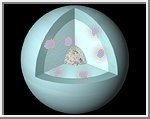a brief history of ooranye
32: the mascon expeditions
[continued from 31: The Era of Psi]

What the people of Syoom desperately needed now was a cheerful, extrovert era. And this is what they got: a healthy time of exploration and zestful life – with the added, unexpected good fortune of a new frontier to explore.
Era 83, the Bismuth Era, lasted 13,324,486 Uranian days or 542 Uranian years, equivalent to 45,600 Earth years. From the word go it was widely agreed that Syoom ought to look in some new direction, to recover its mental poise after the stresses of psi.
Of course Fyaym provided an endless challenge, an infinitely varied challenge, as always. But – partly because of the forces roused by the crisis itself – Fyaym just then was too dismally dark and spiritually perilous to attract a people still reeling from the loss of a powerful talent. During the early part of this period, therefore, adventurers into Fyaym were unusually few.
The people who now were most looked up to as potential saviours were the inventors, scientists and researchers who might be able to provide the romance and the solace of discovery, now that the glow of psi-communion was gone. The lone genius inventor type, in particular, became a distinctive hero of this age. And one such person did succeed in perfecting what came to be the symbol of the Bismuth Era – the vehicle known as the tetrak.
This was a mechanical mole, shaped somewhat like the one used to discover Pellucidar in E.R.Burroughs’ At The Earth’s Core, but properly steerable, and no mere digger. In fact, like the probe Lambda One in the Colin Kapp story of that name, it phased into a vibrational mode which allowed it to interpenetrate the molecules of normal matter, so as to be able to move like a ghost through solid rock.
The tetrak was used during the Bismuth Era to explore the mascon worlds in the ice-crust of Ooranye. The number of expeditions was limited – the authorities did not wish to disturb the planetary equilibrium – but these amazing adventures acted as an inspiration for others up on the surface. All in all, the Bismuth was one of the most splendid eras. And it did not decline; it ended abruptly with a piece of monumental villainy.











































